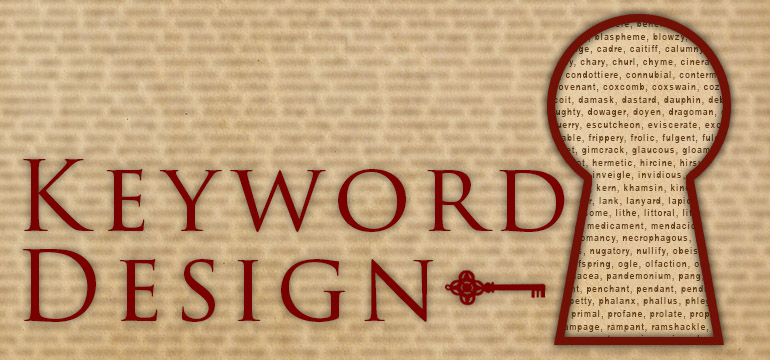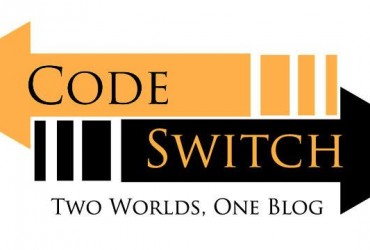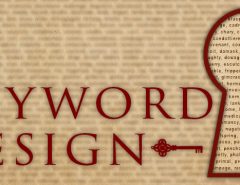In Keyword Design, I use a single word as inspiration for a mundane item, a magic item, a feat, a spell, and a class option. Today’s word is “key” as suggested by Caroline.
First of all, we must all applaud Caroline for her wit. Seeing her suggestion made me laugh out loud, and I mean that literally and in the classic sense of literally… Why is it so hard to say that I actually laughed without it maybe being taken figuratively?
Second of all, what a great suggestion! Key is a diverse word. I thought Caroline was being funny in a meta way, but key has a bunch of meanings. More than any other word I’ve done yet, I believe. I’m only disappointed that I couldn’t come up with an option for key islets (like the Florida Keys).
| “Key” | ||
| TYPE | NAME | DESCRIPTION |
| Mundane Item | Cipher | A note detailing how to create and uncover hidden messages |
| Magic Item | Safecracker’s Keyring | A set of rings that can be expended to disable locks and avoid traps |
| Feat | Change Key | Change from one bardic performance to another more quickly |
| Spell | Secret Path | You leave a trail invisible to all but those you choose |
| Class Option | Geomanki monk archetype | A martial artist that dismantles objects like most monks stun the living. |
New Mundane Items
CIPHER
Price 50 gp; Weight –
Without understanding its purpose, this small paper could be mistaken for a gibberish alphabet or a collection of familiar letters and unfamiliar symbols. Its true purpose is to track and spread the solution for encoded messages. Unless a character has prior experience with ciphers, identifying a cipher requires a DC 5 Linguistics check. A cipher allows the user to use the Linguistics skill to convey and decipher secret messages in writing, using the same DCs as the convey secret message use of the Bluff skill. Additionally, a cipher grants characters who have studied the cipher for at least 1 hour that day a +2 circumstance bonus on Bluff checks made to convey a secret message to other characters. The targets of this secret message must have also studied the same cipher for 1 hour that day. Up to four characters can study the same cipher at one time.
Hey, did you know it’s cipher with an i, not cypher with a y? I didn’t. Apparently all those times it’s spelt with Y, the speller is trying to be cool, or they made the same mistake as me and didn’t correct it. It’s so common that cypher isn’t even a spelling error, even if there is no etymological basis for that spelling.
This was originally just going to give a bonus to Linguistics skill checks to write encoded messages. Ends up, that’s not something you can do with the Linguistics skill. Well now you can! Also, you can develop an amateur thieves’ cant. Look at you, developing thieves’ cants.
New Magic Item
SAFECRACKER’S KEYRING
Aura strong abjuration; CL 8th
Slot none; Price 25 000 gp; Weight 1 lbs
DESCRIPTION
Three ornate charcoal keys hang off this smooth silver ring, although there is no evident way in which the keys could be added or removed. Despite being a continuous circle, a safecracker’s keyring can be looped through and removed from the owner’s belt as a free action, As long as a key remains on the ring, a safecracker’s keyring functions as a set of masterwork thieves’ tools. The wearer can expend a key as a standard action to cast knock as the spell but with a range of touch. Alternatively, they can expend a key as an immediate action to gain evasion until the beginning of their next turn. Keys expended in this way regenerate the next day, generally at dawn although whoever crafts the safecracker’s keyring chooses the time of day that their keys renew. CONSTRUCTION
Requirements Craft Wondrous Item, knock, jump; Cost 12 500 gp
I’m really happy with this. The idea is that you can use a key to unlock a door, or to save yourself from a trap. The unintended consequence is that you can use a key to avoid a fireball. It goes against the safecracker theme but it makes you a bit of an emergency rogue. And although you can gain evasion up to three times in a day, the third time leaves you without masterwork thieves’ tools. Worth saving your life, but not without its consequences.
New Feat
CHANGE KEY
You can deftly switch between different musical performances.
Prerequisites: Bardic performance or similar ability
Benefit: You can change one bardic performance from one effect to another as a move action. If you have the ability to start a bardic performance as a move action, you can change bardic performances as a swift action. If you can start a bardic performance as a swift action, once per day you can change bardic performances as a free action, creating and maintaining both magical effects for 1 round.
This is my most “it all started with the keyword” of this installment. I was looking for other meanings of key that I hadn’t turned into an option yet and musical keys came to mind. “Changing keys” was a familiar term so I tried to figure out something related to bards that made sense with that term.
New Spell
SECRET PATH
School divination; Level bard 2, bloodrager 2, cleric/oracle 3, druid 3, ranger 1, shaman 3, sorcerer/wizzard 3, summoner 3, witch 3
CASTING
Casting Time 1 hour
Components V, S, M (loaf of bread)
EFFECT
Range touch
Target you and 1 piece of bread/2 levels
Duration 1 hour/level
Saving Throw none; Spell Resistance no
DESCRIPTION
Any creature who eats a piece of the loaf of bread you enchant with this spell (up to the number of pieces of bread you can enchant) automatically knows your location, as locate creature, for the duration of the spell. Every round they can spend a standard action to learn the shortest, most direct physical route to your current location, as find the path. You don’t need to be in the same location as the loaf of bread after the spell is cast.
So here we have a spell that mimics the effects of two other spells, both of which are higher level than this spell. Locate creature is a powerful spell in combination with teleport for kidnapping assassinations, but it’s less powerful if it only finds allies. Likewise, find the path can spoil a good maze, but with the limitations this spell applies to it, it’s not nearly as powerful. One thing it can do is give GMs adventure hooks. The PCs find a loaf in a missing person’s kitchen with “Eat Me” written on a sign next to it. A nefarious doctor has been treating a patient with potions of secret path and then feeding local animals enchanted bread to drive the patient crazy.
Also, maps have keys, this spell grants allies the key to finding you. Keys!
New Class Option
GEOMANKI
What started with a mastery in breaking bricks developed into the ability to supernaturally influence objects.
Skills: A geomanki gains Disable Device and Knowledge (enginerring) (Int) as class skills.
Weapon and Armor Proficiency: In addition to the standard monk weapon proficiencies, a geomanki is proficient with using engineering tools like forging hammers and leather straps as improvised weapons, and treats such improvised weapons as monk weapons for the purpose of flurry of blows.
Brick Breaker (Su): A geomanki gains Improved Sunder as a bonus feat at 1st level, Greater Sunder at 6th level, and Sundering Strike at 14th level. Additionally, a geomanki adds his Wisdom modifier to checks to break and sunder objects and weapons. This is in addition to his Strength modifier. This ability replaces the bonus feats gained at 1st, 6th, and 14th level.
Construct Stunner (Ex): A geomanki is able to affect constructs with his stunning fist, even though constructs are normally immune to such effects. He can still target other creatures with his stunning fist but targeting any creature other than a construct uses up two uses of his stunning fist for that day.
This ability alters stunning fist.
Picking Up the Pieces (Ex): At 2nd level, when a geomanki breaks an item with at least one hand free, he can choose to hold onto parts of the broken item to adapt his unarmed strikes. When attacking while wielding parts of a broken item, he can choose to count his unarmed strikes as piercing, slashing, or bludgeoning. Broken parts last a number of rounds equal to the geomanki’s Wisdom modifier. When wielding broken parts, the geomanki’s hand is considered occupied but his attacks are still considered unarmed strikes. Alternatively, a geomanki can use broken parts as thieves’ tools. After one attempt, the broken parts become useless. At 10th level, he can treats broken parts as masterwork thieves’ tools. This replaces the bonus feats gained at 2nd and 10th level.
Opening Palm (Ex): At 5th level, a geomanki can focus the vibrations of a hand on a locked door or chest in such a way that it guides tumblers into place. By spending 1 point from his ki pool as a swift action, he gains a +10 bonus on Disable Device checks made to open locks for one attempt.
This ability replaces high jump.
Greater Opening Palm (Ex): At 18th level, when a geomanki uses opening palm, he can choose to instead spend 2 ki points to unlock the a lock without needing to roll Disable Device. This takes 20 times longer than unlocking the door normally would.
This ability replaces the bonus feat gained at 18th level.
This started with a visual idea that became opening palm, then was influenced by Valiant Comics’ geomancers, which are like object whisperers. I didn’t want to go full geomancy because that’s outside what I wanted for this class, but I remember a scene in Unity where Geof the geomancer is leaning his hands and ear against a giant vault door. He says the door is very proud of how it keeps people out but he talked it into opening. Again, that’s not the power source I pictured a monk locksmith using (through vibrations and becoming one with the gears), but it’s a visual jumping off point.
The rest of the stuff kind of happened by accident. What started with a serene image turned into a very smashy monk. Still, I like it. The question is, did I choose a monk option for this keyword because of ki? Even I don’t know.
Thanks again to Caroline for the keyword suggestion. If you have thoughts on the balance and use of these abilities, or you would like to offer a single word that you think can inspire a mundane item, a magic item, a feat, a spell, and a class option, let me know in the comments below.





“Change Key” was quite clever.